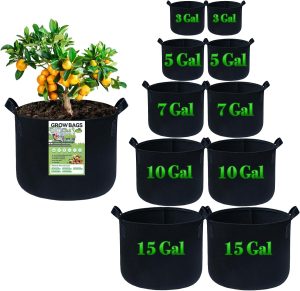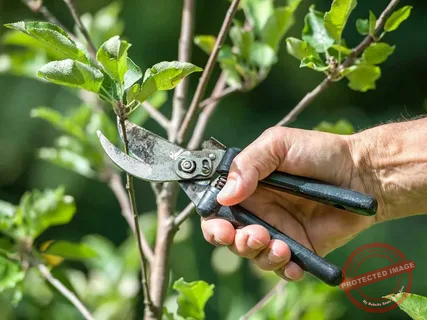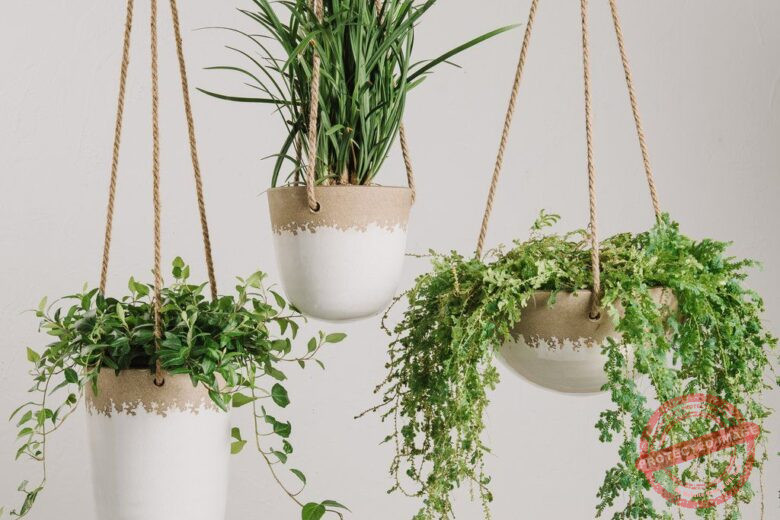What Size Grow Bag for Tomatoes Should You Choose? – Tomatoes are a beloved crop for home gardeners, prized for their juicy flavor and versatility in the kitchen. Growing tomatoes in grow bags is an increasingly popular method due to its flexibility and the ability to control soil conditions.
However, selecting the right size grow bag is crucial for the health and productivity of your tomato plants. In this extensive guide, we’ll delve into the various grow bag sizes, the types of tomatoes they suit best, and practical tips for a successful harvest.
Understanding Grow Bag Sizes

Grow bags come in a variety of sizes, typically measured in gallons. The size you choose will significantly affect the growth and yield of your tomato plants. Here’s a breakdown of common grow bag sizes and their applications:
- Small Grow Bags (1-3 Gallons): Best for very small spaces or dwarf tomato varieties.
- Medium Grow Bags (5-10 Gallons): Suitable for most determinate and smaller indeterminate tomato varieties.
- Large Grow Bags (15-25 Gallons): Ideal for larger indeterminate varieties and for gardeners who want to grow multiple plants in one bag.
Each size has its advantages and limitations. The key is to match the grow bag size with the type of tomato plant and your gardening space.
Small Grow Bags (1-3 Gallons)
Best For: Dwarf tomato varieties, small cherry tomatoes.
Advantages:
- Space-saving: Perfect for small patios, balconies, and windowsills.
- Portability: Easy to move around to catch the best sunlight.
- Less soil required: More cost-effective if you have limited resources.
Considerations:
- Limited root space: Can restrict the growth of larger tomato varieties.
- Frequent watering: Smaller volume means the soil dries out more quickly.
Examples of Suitable Tomato Varieties:
- Micro Tom
- Tiny Tim
- Patio Princess
Growing Tips:
- Soil: Use a high-quality potting mix enriched with compost.
- Watering: Ensure consistent moisture but avoid waterlogging. A self-watering system can be beneficial.
- Support: Even small varieties may need staking or cages to keep the plants upright.
Medium Grow Bags (5-10 Gallons)
Best For: Determinate and smaller indeterminate tomato varieties.
Advantages:
- Versatile: Suitable for a wide range of tomato plants.
- Good root development: Provides adequate space for roots to grow.
- Balanced moisture retention: Larger volume helps maintain consistent soil moisture.
Considerations:
- Space: Requires more room than small grow bags, suitable for medium-sized spaces.
- Weight: Heavier to move once filled with soil and plants.
Examples of Suitable Tomato Varieties:
- Roma
- Celebrity
- Bush Early Girl
- San Marzano
Growing Tips:
- Soil: Use a rich potting mix with good drainage properties.
- Watering: Regular watering is crucial, especially in hot weather. Mulching can help retain moisture.
- Support: Provide cages or stakes to support the plants as they grow.
Large Grow Bags (15-25 Gallons)
Best For: Large indeterminate tomato varieties and growing multiple plants.
Advantages:
- Ample root space: Encourages robust root systems and healthy plant growth.
- Stability: Less prone to tipping over, providing a stable environment for tall plants.
- Moisture retention: Larger volume helps maintain moisture levels, reducing the need for frequent watering.
Considerations:
- Space: Requires a significant amount of space, suitable for large patios or gardens.
- Soil quantity: Requires a large amount of soil, which can be costly and heavy.
Examples of Suitable Tomato Varieties:
- Beefsteak
- Big Boy
- Brandywine
- Cherokee Purple
Growing Tips:
- Soil: Fill with a mix of high-quality potting soil, compost, and organic matter.
- Watering: Ensure deep watering to reach the extensive root system.
- Support: Use strong, tall stakes or sturdy cages to support the large plants.
Choosing the Right Size: Factors to Consider
When deciding on the size of your grow bag, consider the following factors:
- Tomato Variety:
- Dwarf Varieties: These compact plants thrive in small grow bags.
- Determinate Varieties: These bushy plants grow well in medium-sized bags.
- Indeterminate Varieties: These vining plants need the extra space provided by large grow bags.
- Available Space:
- Assess your gardening space. Small bags fit on balconies, while large bags require more room, like a patio or garden.
- Watering Routine:
- Smaller bags need more frequent watering. If you have a busy schedule, larger bags that retain moisture better might be a better option.
- Soil and Nutrient Requirements:
- Ensure you have access to enough high-quality soil. Larger bags require more soil but provide a more stable growing environment.
- Portability:
- If you plan to move your plants around to catch the best sunlight, consider the weight and manageability of the grow bags.
Practical Tips for Growing Tomatoes in Grow Bags
Regardless of the size of your grow bag, here are some general tips to ensure a bountiful tomato harvest:
- Location:
- Place your grow bags in a sunny spot with at least 6-8 hours of direct sunlight per day. Tomatoes need ample sunlight to produce fruit.
- Soil:
- Use a high-quality potting mix with good drainage. Mix in compost or slow-release fertilizer to provide essential nutrients.
- Watering:
- Consistent watering is crucial. The soil should be kept moist but not waterlogged. In hot climates, consider using a drip irrigation system or self-watering grow bags.
- Feeding:
- Tomatoes are heavy feeders. Use a balanced fertilizer regularly to ensure they receive the necessary nutrients. Organic options like fish emulsion or compost tea are great choices.
- Support:
- Even determinate varieties benefit from some support. Use stakes, cages, or trellises to keep the plants upright and prevent the fruit from touching the ground.
- Pruning:
- Prune suckers (the small shoots that grow between the main stem and branches) to encourage better airflow and prevent disease.
- Mulching:
- Apply a layer of mulch on top of the soil to retain moisture, regulate soil temperature, and reduce weed growth.
- Pest and Disease Management:
- Keep an eye out for common tomato pests like aphids and caterpillars. Use organic pesticides or introduce beneficial insects to keep them in check. Practice crop rotation and clean up plant debris to prevent diseases.
Conclusion
Choosing the right size grow bag for your tomatoes is essential for a successful and bountiful harvest. Whether you’re working with a small balcony or a spacious garden, there’s a grow bag size that will suit your needs. Small grow bags are perfect for dwarf and compact varieties, medium grow bags cater to most standard tomato types, and large grow bags provide the space needed for vigorous, indeterminate varieties.
By considering the specific needs of your tomato plants, the space available, and your gardening habits, you can select the ideal grow bag size to ensure your tomatoes thrive. With the right care and attention, you’ll enjoy delicious, home-grown tomatoes all season long. Happy gardening!
FAQs
What is the best grow bag size for cherry tomatoes?
Cherry tomatoes are generally smaller and more compact compared to other varieties. For cherry tomatoes, a grow bag size of 5-10 gallons is ideal. This size provides adequate space for the root system to develop, ensuring healthy growth and good fruit production. If you’re growing a dwarf or micro variety of cherry tomatoes, you could even opt for a smaller grow bag of 3-5 gallons.
2. Can I grow multiple tomato plants in one grow bag?
Yes, you can grow multiple tomato plants in one grow bag, but the size of the bag is crucial. For multiple plants, it’s recommended to use a larger grow bag, ideally 15-25 gallons. This size will ensure each plant has enough space for its root system and won’t compete excessively for nutrients and water. Typically, for a 15-25 gallon grow bag, you can grow 2-3 determinate tomato plants. Ensure you space the plants adequately and provide proper support.
3. How often should I water tomatoes in grow bags?
Tomatoes in grow bags generally require frequent watering, especially during hot and dry weather. The exact frequency depends on the size of the grow bag and the environmental conditions. Smaller grow bags (1-3 gallons) may need daily watering, while larger grow bags (15-25 gallons) may retain moisture longer and need watering every 2-3 days. Always check the soil moisture; it should be kept consistently moist but not waterlogged. Mulching can help retain moisture and reduce the frequency of watering.
4. What type of soil is best for tomatoes in grow bags?
The best soil for growing tomatoes in grow bags is a high-quality, well-draining potting mix. It’s essential to use soil that retains moisture while providing good aeration. A mix that includes compost or organic matter is beneficial as it provides necessary nutrients. Adding perlite or vermiculite can improve drainage and prevent the soil from becoming compacted. Avoid using garden soil, as it can be too heavy and may contain pests or diseases.
5. How do I provide support for tomatoes in grow bags?
Tomatoes, especially indeterminate varieties, need sturdy support to keep the plants upright and prevent the fruits from touching the ground. There are several methods to provide support:
- Stakes: Drive a stake into the grow bag and tie the main stem of the tomato plant to the stake as it grows.
- Cages: Place a tomato cage around the plant early in its growth. This supports the plant as it branches out.
- Trellises: Set up a trellis system where the grow bags are positioned near a wall or fence, and the plants can be tied to the trellis for support.
- DIY Structures: You can create custom support structures using bamboo sticks, string, or other materials.
Ensure the support is installed early to avoid damaging the roots and stems of the growing plants. Regularly check and adjust the ties to ensure the plant is securely supported but not constricted.



